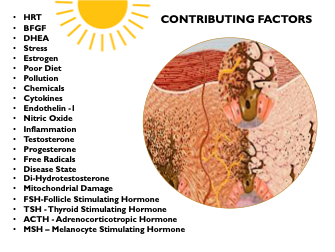Tyrosinase Inhibitors For Hyperpigmentation
Using Tyrosinase Inhibitors are a modern standard in treating hyperpigmentation, which is one of the most perplexing skin concerns for both estheticians and clients. From the residual discolorations from post-inflammatory acne scars to the deeply situated hyperpigmentation from melasma – pigmentation is both problematic and unpredictable. It is estimated that approximately 5 million people in the United States and up to 40% of certain populations are melasma sufferers. This figure does not take into consideration the remaining variants of both hypo and hyperpigmentation abnormalities. One fact that remains clear is that unwanted skin pigmentation is frequently unresolved and often reoccurs due to several variables.
One of these variables is the uncertainty of the etiology and pathogenesis of the pigmentation. The primary concern is to determine the potential source or cause for the development of the pigmentation, as this is a key consideration before the treatment approach can be determined. An aggressive approach tends to bring residual inflammation development, contributing to a cyclic return of the pigmentation, and is frequently more pronounced than previously. As has been the case with the traditional recommendation of hydroquinone, which for decades was the gold standard for the management of pigmentation. The structural similarity between hydroquinone and melanogenic precursors enabled the hydroquinone interaction with tyrosinase to “lighten” the pigmentation.

Contribution by Dr. Erin Madigan-Fleck
Hydroquinone and Pigmentation
Hydroquinone was also thought to inhibit pigmentation by depleting glutathione, modifying melanosome functions, or by inhibiting DNA and RNA synthesis with selective cytotoxicity toward melanocytes and melanocyte destruction. Concentrations of hydroquinone were prescribed ranging from 2 to 5%. Higher concentrations although claimed to be more effective, caused more irritation. Side effects from hydroquinone included: erythema, permanent leukoderma, skin irritation, contact dermatitis, impaired wound healing, halo shaped hypopigmentation, chemical mitosis, and endogenesis ochronosis causing a deficiency of the enzyme oxidase which oxidizes homogentisic acid – a metabolite of tyrosine and phenylalanine. This produced in many long-term hydroquinone users a deeply positioned black-brown pigmentation in the dermis which necessitated laser treatment. As a part of the CARES Act in congress – hydroquinone was to be removed from all over the counter products in 2020 because of safety concerns surrounding cytotoxicity to cells, and the potential misuse of hydroquinone by the public.
Abnormal pigmentation development is not initiated by a single factor, but includes many co-factors involving molecular biosynthesis of the human body in conjunction with age, inflammation, ethnicity, sun exposure hormones, and more. Lesser-known influences regarding abnormal pigmentation development include oxidative stress, DNA mutations, mitochondrial damage, telomere shortening, nutrient deficits, hormone imbalances, chemical exposure, the environment, medications, and even nicotine. The effective treatment of pigment disorders is characterized by influence of melanin formation, but it must be always realized and targeted to the other histopathological processes in the skin. This is both a cosmetic chemistry and physiological consideration and generally non-negotiable fact regarding a successful treatment pathway.
Pigmentation Development
© Erin Madigan-Fleck NMD
To understand how to manage pigmentation, we need to understand how melanin develops. Melanin is synthesized by a cascade of enzymatic and chemical reactions and its production is mainly controlled by the expression and activation of tyrosinase.

Melanogenesis Fast Track Explanation:
ACTIVATION
Chemical signals from other cells in the skin cause the melanocyte to activate the amino acid L -tyrosine into tyrosinase and begin melanin synthesis.
SYNTHESIS
Melanin is manufactured, and “packaged” into elliptically shaped containers called melanosomes. Melanin is then relocated to the outer regions of tentacle-like projections of melanocytes called dendrites.
EXPRESSION
Melanin-filled melanosomes are then transferred from the ends of dendrites to keratinocytes (surrounding cells in the skin) for shipment to the surface of the skin. Sun exposure and other factors transcribe melanin to the surface.
Tyrosinase Inhibitors
Work by interrupting the enzyme tyrosinase which assists in oxidizing the amino acid l-tyrosine, needed to form melanin in the melanosome. Tyrosinase is a copper containing enzyme that catalyzes the production of melanin from L-tyrosine by oxidation found inside melanosomes which are synthesized in melanocytes. Tyrosinase mechanism-based inhibitors act to suppress developing hyperpigmentation by denaturing the enzymes, binding to tyrosinase, and inhibiting its activity. The term “bleaching” is inaccurate when used to describe tyrosinase inhibitors, as they are catalysts for the deactivation of tyrosinase helping to develop melanin pigment itself. Whereas skin “lightening and brightening” agents are focused on pigmentation that is situated. Many tyrosinase inhibitor products are formulated to have the potential to focus as dual performance agents simultaneously acting as both brightening agents and tyrosinase inhibitors.
Into the Light – 47 Brightening Agents and Tyrosinase Inhibitors
- AHA’s
- Aloesin
- Alpha tocopherol
- Arbutin
- a. Bisporus Mushroom
- Bearberry extract
- Azelaic Acid
- Ellagic Acid (EA)
- Gallic Acid
- Gastrodia elata (Chinese Herb)
- Gingko Biloba
- Ginseng
- Glutathione
- Glycolic Acid
- Green Tea
- Guioa villosa
- Hesperidin
- Hydroquinone
- Hydroxycinnamic acid
- Hydroxycinnamoyl
- Hydroxystilebne
- Kojic Acid
- Lactic Acid
- Lemongrass
- Licorice
- Linoleic acid
- Magnesium ascorbyl phosphate
- Matricaria
- Melatonin
- Mondia whitei
- Mequinol
- Mulberry Extract
- N acetyl glucosamine
- Niacinamide
- Panax ginseng
- Pinus pinaster bark extract
- Pulsatilla cernua
- Retinoids
- Salicylic acid
- Sepi-White
- Silymarin (milk thistle)
- Soy
- Tranexamic Acid
- Triacylglycerol
- Vanillic acid
- Vitamin C
- Vitex negunds
Tyrosinase inhibitors have been utilized in beauty culture from earlier centuries in China and have been isolated in many plant forms found in nature. The current technologies in cosmetic chemistry have afforded us a vast array of effective products to help manage pigmentation. Combined with equipment and light-based modalities, esthetic treatment, and sound client home care plans, we have been able to treat pigmentation concerns to a much greater extent. The clinical intake of the client’s health, medications, home care regimes, and the in-depth skin assessment are the primary factors for determining the care plan for the management of pigmentation. Most importantly it should be realized that the inhibition of tyrosinase, decreasing of melanocyte metabolism, and avoiding of UV exposure are the primary ways to reduce melanin synthesis.


